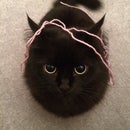Introduction: Custom Table Confetti
For our wedding we wanted something geeky and personal but subtle so we thought a little table confetti would work well. We came up with a few designs we liked and had some friends use their vinyl cutter to make it for us in a nice blue card.
We used a silhouette portrait vinyl cutter generously donated to us by Silhouette and instructables for a vinyl cutter themed build night at our local makerspace So Make It. The confetti turned out great and we are now considering taking orders for custom made confetti for other people :)
Step 1: Choosing Your Images
You could design your own images but chances are there's somebody out there who has already has done it for you so why not try google and search for what you're after.
You'll need to pick something simple without too much detail, tiny parts or floating parts within parts without any ties. Remember, this is going to be cut out on your vinyl cutter and will be small so you will lose tiny details. You can however edit the end result a little so don't be too put off if you cant find anything perfect.
Most of the images you find will of the raster type so will be .GIF, .BMP or .JPG files. These are made up of pixels so you cant use them as they are for cutting and they wont scale up very well. What we are eventually after are vector files and I will explain how to convert them using a free software package called Inkscape.
You can also convert raster images to vector files using the Silhouette vinyl cutter software too but I prefer doing most of my work in Inkscape as you can do so much more!
Step 2: Convert the Image Into a Vector File
Once your image is in Inkscape simply go to the path menu and chose the trace bitmap tool. Default settings for a simple design should be fine but anything more complicated and you may want to tweak things such as thresholds.
Once you click OK the tool will create a new vector on top of the image. Simply drag the vector away and if you are happy with the results delete the old image left in its place.
Step 3: Turn It Into Lines
This step isn't strictly necessary but I find it very helpful for seeing exactly how the design will cut. If you have additional work to do this is especially useful.
You just need to set the fill to none and make sure you set the stroke to something you can see. In this case I've just picked black.
Step 4: Saving It to the Correct Format for the Vinyl Cutter
The Silhouette vinyl cutters basic software needs files of a certain type. In this case we need to save the file in the "Desktop Cutting Plotter AutoCAD DXF" format as shown.
An options box will ask about additional details for the file to save as and you will need to tick "use ROBO-Master type of spline output" and untick "Use LWPOLYLINE type of line output" which is the opposite of the defaults.
Step 5: Duplicate and Nesting Your Design
Once you have loaded the file into the Silhouette Vinyl cutter software you should choose a sensible size in which you want to cut the design out at. Stretch out the design until you are happy with its size.
We don't want to waste a whole piece of cardstock for 1 piece of confetti of course so we'll use the replicate menu and chose "fill page" and this will fill the current page with your design. You can tweak the settings in the advanced menu to try to fit even more designs onto one page or manually move around the designs when done.
Those who have the designer version of Silhouette studio will have a feature called "Nesting" and this will be able to help you pack even more designs onto one sheet.
Step 6: Finished!
The table confetti looked fantastic on our wedding day and gave the tables a subtle personal touch. We ended up picking:
A Tardis for our mutual love of sci-fi
A cat because we weren't allowed to bring our cat to the wedding
A mickey mouse because we planned to honeymoon at Disneyland Paris
A batman symbol well...just because :)

Participated in the
Wedding Contest









